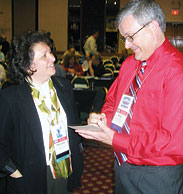Mike Maynard, QSC business coach, emceed the event. Encouraged by the good turnout, he noted that 217 people attended the meeting, including five contractors who signed up as new members before the meeting was half over.
The new and current members heard discussions on three topics: husband-wife teams working together, organizing and prioritizing, and getting employees involved and motivated.
Husband And Wife Teams
Three husband-wife teams fielded questions from the audience on the keys to working together, while managing to maintain a rewarding personal life. Ron and Sharon Collier of Collier Consulting Group, Dripping Springs, Texas, agreed that it is difficult for their workers to know who to turn to, since both of them are considered "the boss."Ron added, "Turning the business loose at 5 p.m. is very difficult. We will find ourselves talking about the business when we have time, which is usually after 5 p.m."
One QSC member suggested setting a cutoff time of 7 p.m. to stop talking about business. Another suggested that the husband and wife have a "date night" where they can be more at ease and discuss business issues in a relaxed atmosphere.
Suggestions from other audience members included husband and wife sharing a common interest outside of work, and getting their children involved by explaining the business to them and what it takes to run the business.

Organizing, Prioritizing
QSC members discussed ways to "get the piles of paperwork off the desk." Suggestions included knowing when to throw out paperwork that is going unread. One member said, "If the paperwork is more than seven days old, it isn't important enough to keep."Other suggestions included letting every employee know what is expected of them rather than waiting for them to ask; organizing procedures from the moment the telephone rings until the job is paid for; and leading by example - if the boss is organized employees will be too.
QSC contractor Roger Fouche of Schaal Heating & Cooling Inc., Des Moines, Iowa, said he noticed that some of his part-time workers were doing more work and being more efficient than some of the full-time staff. He eventually hired all part-time workers for his office, working swing shifts. "I found out that more people wanted part-time work," he said. "And I don't have to pay full-time benefits."
Motivating Employees
Maryann Swift of Basnett Plumbing & Heating, Littleton, Mass., offered an example that keeps employees involved and motivated in her company's business. Swift said her company rolls out the "Challenge Board" during each weekly or biweekly meeting.The Challenge Board contains a list of questions - technical and general - slotted into different clear plastic sleeves on a large board. Each sleeve also contains money in different denominations. Employees can choose a question, based on the dollar value, and if they get the answer correct, they win the money. If they incorrectly answer the question, the author of the question (another employee) wins the cash.
Swift said that contractors could also use incentives other than cash, such as gift certificates or gift cards. Regardless of the incentive, she said her company is a great example of how to improve employee relations.
"In the last year we have used the Challenge Board, we have seen increases in technician productivity, attendance at meetings, and retention of knowledge from training," she said.
For more information on QSC, visit www.qsc-phcc.org.
Publication date: 04/25/2005
